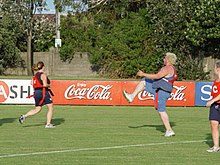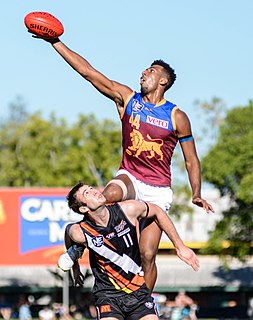
Australian football, also called Australian rules football or Aussie rules, or more simply football or footy, is a contact sport played between two teams of 18 players on an oval field, often a modified cricket ground. Points are scored by kicking the oval ball between the central goal posts, or between a central and outer post.
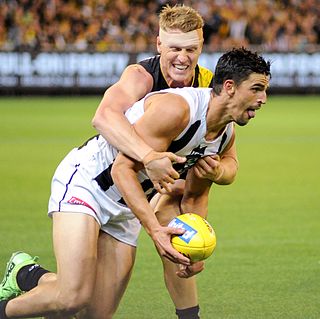
Most forms of football have a move known as a tackle. The primary purposes of tackling are to dispossess an opponent of the ball, to stop the player from gaining ground towards goal or to stop them from carrying out what they intend.

In sport, a goal may refer to either an instance of scoring, or to the physical structure or area where an attacking team must send the ball or puck in order to score points. The structure of a goal varies from sport to sport, and one is placed at or near each end of the playing field for each team to defend. For many sports, each goal structure usually consists of two vertical posts, called goal posts, supporting a horizontal crossbar. A goal line marked on the playing surface between the goal posts demarcates the goal area. Thus, the objective is to send the ball or puck between the goal posts, under or over the crossbar, and across the goal line. Other sports may have other types of structures or areas where the ball or puck must pass through, such as the basketball hoop.

International rules football is a team sport consisting of a hybrid of football codes, which was developed to facilitate international representative matches between Australian rules football players and Gaelic football players.

Tag rugby, or flag rugby, is a non-contact team game in which each player wears a belt that has two velcro tags attached to it, or shorts with velcro patches. The mode of play is based on rugby league with many similarities to touch football, although tag rugby is often deemed a closer simulation of the full contact codes of rugby than touch. Attacking players attempt to dodge, evade and pass a rugby ball while defenders attempt to prevent them scoring by "tagging" – pulling a velcro attached tag from the ball carrier, rather than a full contact tackle. Tag rugby is used in development and training by both rugby league and rugby union communities.
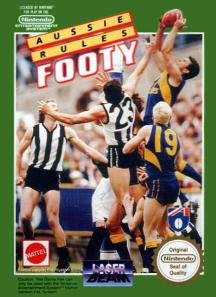
Aussie Rules Footy is the first AFL simulation video game for the Nintendo Entertainment System. It was developed by Melbourne based Beam Software and published under their "Laser Beam" publishing title in 1992. The release was Australian-only with distribution handled through Mattel's Australian operations.

A mark in Australian rules football is the catch of a kicked ball which earns the catching player a free kick. The catch must be cleanly taken, or deemed by the umpire to have involved control of the ball for sufficient time. A tipped ball, or one that has touched the ground cannot be marked. Since 2002, in most Australian competitions, the minimum distance for a mark is 15 metres.
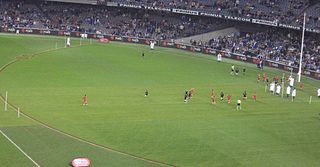
Auskick is a program designed to teach the basic skills of Australian rules football (AFL) to boys and girls aged between 5 and 12. Auskick is a non-contact variant of the sport. It began in Australia and is now a nationwide non-selective program. It has increased participation and diversity in the sport amongst children, and is now being run in many countries across the world.

The laws of Australian rules football were first created by the Melbourne Football Club in 1859 and have been refined over the years as the sport evolved into its modern form. The laws significantly predate the advent of a governing body for the sport. The first national and international body, the Australasian Football Council (AFC), was formed in 1905 and became responsible for the laws, although individual leagues retained a wide discretion to vary them. Since 1994, after the establishment of a nation-wide Australian Football League (AFL), the rules for the game have been maintained by the AFL Commission through its AFL Competition Committee.
In the sport of Australian rules football, the 50-metre penalty is applied by umpires to a number of different infractions when a free kick or mark has already been paid.

Women's Australian rules football, is the female-only form of Australian rules football, generally with some modification to the laws of the game.
Nine-a-side football is a sport based on Australian rules football played informally by Aussie rules clubs but not yet an official sport in its own right.

A free kick in Australian rules football is a penalty awarded by a field umpire to a player who has been infringed by an opponent or is the nearest player to a player from the opposite team who has broken a rule.

Indoor netball is a variation of netball, played exclusively indoors, in which the playing court is surrounded on each side and overhead by a net. The net prevents the ball from leaving the court, reducing the number of playing stoppages. This gives indoor netball a faster pace than netball.
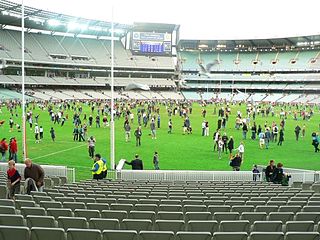
Kick-to-kick is a pastime and well-known tradition of Australian rules football fans, and a recognised Australian term for kick and catch type games. It is a casual version of Australian rules.

Shepherding is a tactic and skill in Australian rules football, a team sport. Shepherding is the act of legally pushing, bumping or blocking an opposing player from gaining possession of the ball or reaching the contest.
Variations of Australian rules football are games or activities based on or similar to the game of Australian rules football, in which the player uses common Australian rules football skills. They range in player numbers from 2 up to the minimum 38 required for a full Australian rules football.

This list is an alphabetical glossary of Australian rules football terms, jargon and slang. While some of these entries are shared with other sports, Australian rules football has developed a unique and rich terminology.
League Tag is the name of two distinct modified version of rugby league football. Both versions of League Tag maintain the basic structure of rugby league, and replace physical tackling with an alternate means to end each play.
There are various individual skills and team tactics that are required to play Australian rules football effectively. These are dictated by tradition and the sport's laws.
